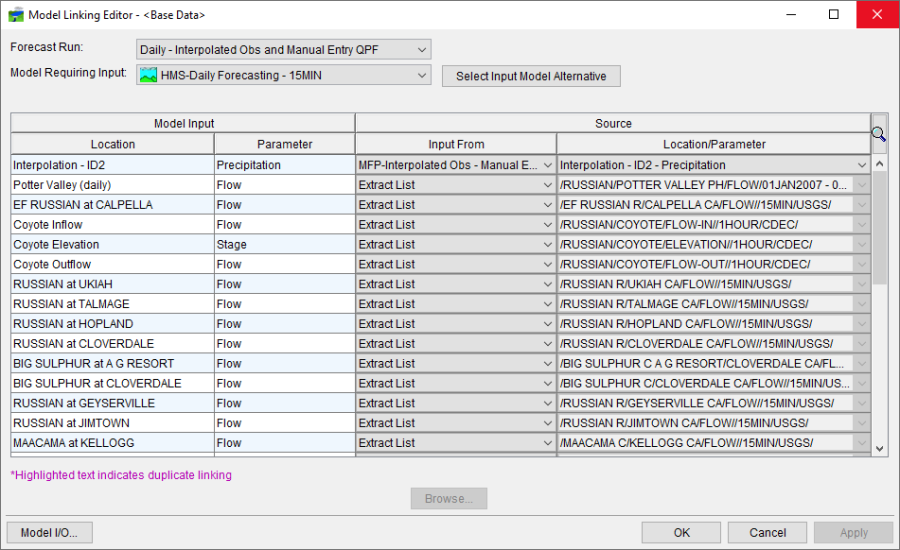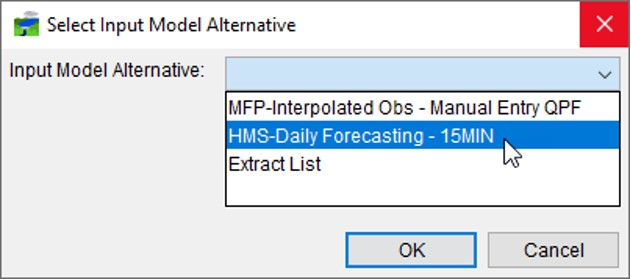Model Linking Editor Overview
At the top of the Model Linking Editor, from the Forecast Run list (Model Linking Editor) you will select the forecast run that needs to be linked. The Model Requiring Input list (Model Linking Editor) displays the model alternatives configured for use in the selected forecast run. To complete the model linking process for a given forecast run, you will need to step through all the model alternatives listed in the Model Requiring Input list. The remaining portion of the Model Linking Editor is the table which lists the inputs required by the model alternative selected in the Model Requiring Input list and the source of that input. Figure 1 shows an example of the Model Linking Editor for the Russian River watershed with an HEC-HMS model alternative requiring input. 
This table has four columns:
- Location. This column identifies the name of the required input. For example, this could be:
- The precipitation grid name or discharge gage name specified in the HEC-HMS model alternative.
- The local flow name specified in the HEC-ResSim model alternative.
- The river station and node name specified in the HEC-RAS model alternative.
- Parameter. This column identifies the type of data or information required by the model alternative. For example, this could be flow, stage, or precipitation.
- Input From. This column consists of lists that identify the source of the input. These lists display each available model alternative from the selected forecast runs and Extract List. Extract List is used to bring data and information from external sources (i.e., DSS files), into the watershed. Refer to Data Extract and Post Editors for additional information on the Extract Editor.
- Location/Parameter. If the Input From column displays the name of a model alternative, this column provides a list that contains all model alternative results for the parameter specified in Parameter column. For example, in Figure 1, the first row in the table indicates that the Interpolation – ID2 precipitation input should come from the MFP model alternative named MFP-Interpolated Obs – Manual Entry QPF. If the Input From column displays Extract List, this column will display either a DSS pathname or a CWMS database pathname.
Select Input Model Alternative
The Select Input Model Alternative (Figure 2) provides a user with a way to set all the Input From values equal to a specific model alternative or Extract List. For example, you may want all the HEC-ResSim model alternative inputs to come from the HEC-HMS model alternative results. Click Select Input Model Alternative, the Select Input Model Alternative dialog (Figure 2) opens. From the Input Model Alternative list (Figure 2), select a model alternative (or Extract List), click OK, the Select Input Model Alternative dialog (Figure 2) closes.

A Confirm Input Selection window will open, asking do you want to link all unlinked rows to the selected Input Model Alternative. Click Yes, the Confirm Input Selection window will close. All rows in the table that were not linked, will now be linked to the selected Input Model Alternative.
Select Source Data Location
Are you having difficulty determining for a specific location what the correct parameter might be? From the Model Linking Editor (Figure 1), select a Location (i.e., Ukiah Gage – FLOW), click Browse, the Select Source Data Location dialog will open (Figure 3). In this dialog you can scroll through the entire list of available locations and parameters for the selected model alternative (HMS-Daily Forecasting – 15 MIN). Once you have found the correct location (i.e., Ukiah Gage), review the available parameters, select the row in the Select Source Data Location dialog (Figure 3) that contains the correct parameter (i.e., Flow). Click Set Location (Figure 3), for the selected Location in the Model Linking Editor (Figure 1), the Location/Parameter column will display the selected parameter. To close the Select Source Data Location dialog (Figure 3), click Close.
